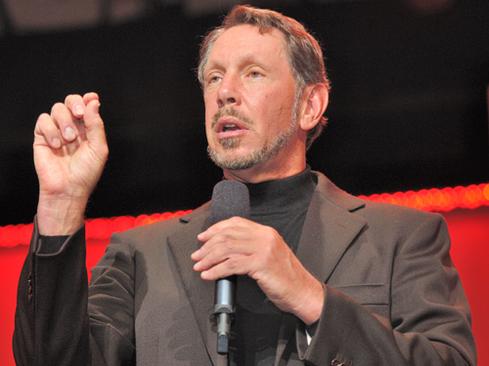Oracle CTO Ellison Does DemosOracle CTO Ellison Does Demos
Oracle cloud platform-as-a-service lets you modernize apps while lowering costs, says Larry Ellison in a show-and-tell session at Oracle OpenWorld.


10 New Side Projects For Larry Ellison
10 New Side Projects For Larry Ellison (Click image for larger view and slideshow.)
Oracle executive chairman and chief technology officer Larry Ellison took the OpenWorld stage on Tuesday to detail, through live demonstrations, advantages of Oracle's platform-as-a-service that he described in his Sunday night kickoff speech.
It's unusual for corporate chairmen to do tech demos -- though his septuagenarian peer, SAP chairman Hasso Plattner, has also made it a habit -- but Ellison wanted to show that it's possible to "modernize and lower the cost" of on-premises applications by moving them into Oracle's cloud "with a single click."
Alone on the stage, Ellison joked, "I'm CTO now, so I have to do my demos by myself." He then went through the process of moving a demo application and its underlying database instance from an on-premises server to Oracle's PaaS, which comprises the Oracle Database Cloud Service and the Oracle Java Platform Service. In both cases it took more than a single click, technically, but he used the Oracle Enterprise Manager interface in both environments, and the moves were completed in less than 10 minutes.
[Want more on OpenWorld news? Read Oracle Lets Customers Shift License Money To Cloud.]
Oracle PaaS will enable customers to "lower costs precipitously," said Ellison, in part because the database service is loaded with automation features that will "dramatically reduce" administrative costs.
"Not only do we provision whatever compute and storage resources you need automatically, we automatically back up the database, let you recover to any point in time, and automatically log," Ellison said. "It automatically patches and upgrades the database, and Data Guard and RAC [high-availability features] are automatically provisioned." The many automation features make it easier to manage database instances while reducing human error and improving reliability, Ellison said.
Getting customers to choose Oracle PaaS instead of the underlying infrastructure-as-a-service (IaaS) is a win for Oracle because it gets it out of what Ellison and CEO Mark Hurd have described as a commodity business, with thin margins up against the likes of Amazon Web Services and Microsoft Azure. But customers also win, Ellison and Hurd have reasoned, because they're lowering their overall cost through administrative savings even if they're paying Oracle more than they would for IaaS alone.
"Oracle 12c running on our Oracle Database Cloud Service is much more automated than Oracle 12c running on-premises or running on infrastructure-as-a-service," Ellison said.
As for the application-modernization promise, Ellison noted that apps moved from on-premises to Oracle PaaS would benefit from 10-to-1 compression and in-memory processing features in Oracle 12c that will dramatically improve performance. Data is also automatically encrypted when it's moved to the cloud, and the platform's mobile, social, and analytic services make it possible to add these capabilities even to customized and home-grown apps, as long as they're written in Java. Non-Java apps must be run on Oracle's IaaS, he said.
In one final demo of Oracle PaaS capabilities, Ellison toured an extension employee-of-the-month application that was previously developed using the Oracle Java Platform Service and integrated with Oracle Fusion HCM. "I am CTO now, so I thought I'd demonstrate how to write an HCM extension app in Java, but they told me I could not have an 11-hour session," Ellison quipped.
The point was that Oracle makes the same SQL-and-Java-based platform available to customers that it uses to develop its own apps. That's a contrast with Salesforce.com, which offers a proprietary platform, and with SaaS vendors that don't offer platform services, Ellison said.
With fees yet to be spelled out and Oracle's various deployment options yet to be tested en masse, the total cost of ownership and real customer experience across Oracle IaaS and PaaS options have yet to be seen.
As was the case for Sunday's keynote, Ellison drew a standing-room-only crowd, and he didn't disappoint where his trademark tech vision and humorous sound bites were concerned. Competitors might complain that Ellison needs to double-check his facts and cut back on a few of those "Oracle is the only" claims. But the Oracle OpenWorld audience seems to eat it right up, even if not everyone believes every claim that they hear.
Avoiding audits and vendor fines isn't enough. Take control of licensing to exact deeper software discounts and match purchasing to actual employee needs. Get the Software Licensing issue of information today.
About the Author
You May Also Like






